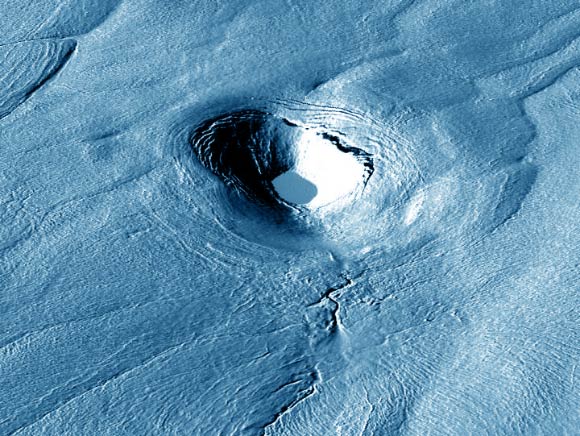Scientists have found direct evidence of concentrated, long-term storage and sudden release of meltwater within sub-glacial lakes in Greenland.

Scientists have discovered a crater, shown here, which had once been the site of a sub-glacial lake. Image credit: Ian Howat / DigitalGlobe Inc / Sci-News.com.
Two teams of researchers – one led by Dr Ian Howat of the Ohio State University, and the other led by Dr Michael Willis of Cornell University – have discovered two lakes of meltwater that pooled beneath the ice and suddenly drained away.
One lake, described in the journal Cryosphere, once held billions of gallons of water and emptied to form a giant crater – 2 km across and around 70 m deep – in just a few weeks.
Dr Howat and his colleagues detected the crater on a spot about 50 km inland from the southwest Greenland coast earlier in 2014.
There, previous aerial and satellite imagery indicates that a sub-glacial lake pooled for more than forty years. More recent images suggest that the lake likely emptied through a meltwater tunnel beneath the ice sheet some time in 2011.
“The fact that our lake appears to have been stable for at least several decades, and then drained in a matter of weeks – or less – after a few very hot summers, may signal a fundamental change happening in the ice sheet,” Dr Howat said.
Dr Howat’s group calculated that the lake that formed it likely contained some 6.7 billion gallons of water.
And it disappeared in a single season – remarkably quickly by geologic standards. The scientists characterized the sudden drainage as catastrophic.
“We suspect that, as more meltwater reaches the base of the ice sheet, natural drainage tunnels along the Greenland coast are cutting further inland. The tunnels carry heat and water to areas that were once frozen to the bedrock, potentially causing the ice to melt faster,” Dr Howat said.
“Some independent work says that the drainage system has recently expanded to about 50 km inland of the ice edge, which is exactly where this lake is.”
“It’s possible that the lake was tapped by one of the invading tunnels. It’s also possible that thousands of such lakes dot the Greenland coast.”
They are hard to detect with radar, and scientists don’t know enough about why and how they form.
The other sub-glacial lake, described in the journal Nature, has filled and emptied twice in the last two years.
Each time the lake fills, the meltwater carries stored heat, called latent heat, along with it, reducing the stiffness of the surrounding ice and making it more likely to flow out to sea.
“If enough water is pouring down into the Greenland Ice Sheet for us to see the same sub-glacial lake empty and re-fill itself over and over, then there must be so much latent heat being released under the ice that we’d have to expect it to change the large-scale behavior of the ice sheet,” said Prof Michael Bevis of the Ohio State University, a co-author of the Nature paper.
Dr Willis, Prof Bevis and their colleagues discovered the lake in March 2013. They were gathering data to supplement their long-standing efforts to weigh the Greenland Ice Sheet with GPS and spotted the mitten-shaped lake by accident.
The scientists calculated that the lake filled and emptied twice since 2012, at one point experiencing a sub-surface blowout that drove water from the lake at a volume of 215 cubic meters every second.
They said that the sudden discovery of the lakes signals that Greenland ice loss has likely reached a milestone.
“It’s pretty telling that these two lakes were discovered back to back. We can actually see the meltwater pour down into these holes. We can actually watch these lakes drain out and fill up again in real time. With melting like that, even the deep interior of the ice sheet is going to change,” Prof Bevis said.
_____
Howat I.M. et al. 2015. Sudden drainage of a subglacial lake beneath the Greenland Ice Sheet. Cryosphere 9, 103-108; doi: 10.5194/tc-9-103-2015
Michael J. Willis et al. Recharge of a subglacial lake by surface meltwater in northeast Greenland. Nature, published online January 21, 2015; doi: 10.1038/nature14116







